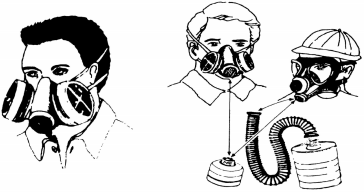The principles of the Occupational Health and Safety Act with regards to the handling of agro-chemicals and fertilisers are explained below.
Safe Handling Of On Farm Chemicals

Click here to download a handout that explains the guidelines for the safe handling of on-farm chemicals
Click here to view a video that explains chemicals and pesticides.
Click here to view a video that explains pesticide safety on the farm.
Protecting Users of Chemicals Against Poisoning: Exposure Prevention
- Avoid exposure to all chemicals. Never allow any chemicals to come in contact with unprotected skin.
- Always wear protective clothing such as coats, gowns, aprons, gloves, and eyewear or face shields.
- Prevent the inhalation of volatile solvents and oil vapours when working in chemical fume hoods or containment devices or areas.
- Ensure that all visitors also wear eye protection and other appropriate personal protection equipment (PPE).
- Access to the chemical storage facilities must be restricted so that only authorised personnel may enter.
- Signs identifying hazardous chemicals are in use must be put up wherever required.
- Never eat, drink, smoke, handle contact lenses, apply cosmetics, or handle foodstuffs while working with chemicals.
- Never measure off a chemical by means of a siphon pipe.
- Always wear a respirator while using chemicals such as formulated products and diluted compounds.
- Ensure you wear specialised gloves and protective clothing if you work with acids.
- Limit the volume of chemicals (posing special hazards or risks) to the minimum quantities required.
- Keep flammables in a flammable storage cabinet.
- Never leave chemicals on the floor where you are working. x Keep a chemical inventory.
- Outdated and obsolete chemicals must be disposed of following a chemical waste disposal program.
- Ensure that you know how to handle spill control kits.
- Clean spills promptly and decontaminate the areas.
- Always place chemical wastes in appropriate and properly labelled containers for disposal.

All chemicals must be considered as potentially poisonous and handled accordingly. The minimum requirements for safe handling of the chemicals are usually stipulated on the label.
In the case of most chemicals it is sufficient to follow a few basic rules as summarised below:
- Always wear rubber gloves when pouring or measuring a concentrate before dilution. Ensure that it is done in such a manner that any fumes or dust will drift away from the applicator.
- Immediately wash off any spillage on the body with soap and plenty of water.
- Wear overalls or other old clothing that will cover most of the body.
- Wash clothes regularly, especially when a pesticide is applied over an extended period of time. Wear a fresh set every new day of application.
- Always keep out of the spray drift or dust cloud during application.
- Never smoke, eat or drink during application. At least, wash the hands and face before doing so during a break.
- Take a bath after completing the application and change into clean clothes. Never continue with another job while still wearing clothes contaminated by a pesticide.
- In the case of highly poisonous pesticides the users must take additional precautions. Special protective clothing in good repair, rubber gloves and boots, headgear, goggles and mask or respirator must be worn. The eyes and respiratory tract must be adequately protected.
- It is a good measure to wear a respirator during the use of any chemical. Ensure the respirator is fitted with a suitable cartridge.
Protecting Users of Chemicals Against Poisoning: Eye Protection
There are a number of different types of protective eyewear available. They range from standard clear lenses to UV protective lenses. If you wear eyeglasses anyway, you should wear special protective eyewear made to fit around you glasses.
There are 6 main classes of protective eyewear.
- Safety Spectacles with side-shields.
- Goggles with a rigid body and a cushioned fit.
- Goggles with a flexible fit and regular ventilation window.
- Face Shield with plastic window.
- Goggles with a flexible fit and hooded ventilation.
- Chipping Goggles, the eyecup type.

The table below indicates which types of eyewear should be used under different circumstances.

Protecting Users of Chemicals Against Poisoning: Chemical Splash Wear
Chemical Splash wear are required when using:
- Concentrated acids or bases.
- Corrosive gases.
- Potentially explosive or water reactive chemicals.
- Acute toxic chemicals (liquid or powder).
- 25 ml or more of hazardous liquid chemicals.
Protecting Users of Chemicals Against Poisoning: Gloves
The correct gloves should be worn depending on the type of chemical. Glove should be selected based on the chemical resistance of the material that it is manufactured from. The table below indicates the chemical resistance of different materials.

Protecting Users of Chemicals Against Poisoning: Respiratory Protection
Respiratory protection is essential when mixing, diluting or applying pesticides or hazardous disinfectants. Remember a facemask is not a respiratory protection. Facemasks only avoid dusts to enter the respiratory tracts. If you work with toxic and hazardous chemicals, you should wear a respirator fitted with a good cartridge. In general, the best cartridge to fit is the agricultural grade cartridge.
